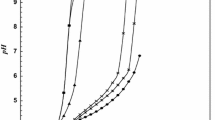Abstract
The protonation equilibria for the flavonoid naringenin were studied at 25∘C using combined multi-wavelength spectroscopic and pH-potentiometric methods as a function of the ionic strength. Over a wide range of ionic strengths, 0.10–3.00 mol dm−3, the investigation was performed in different aqueous solutions of NaClO4 as the background electrolyte. The dependence on ionic strength of protonation constants was modeled by the Brönsted–Guggenheim–Scatchard Specific Ion Interaction Theory (SIT) and Pitzer approaches. Apart from the values of SIT interaction coefficients and Pitzer parameters, the protonation constants at infinite dilution (zero ionic strength) were obtained. On the basis of these results, it was found that Pitzer mode l gives more satisfactory results rather than the SIT method.

Ionic strength dependence of protonation constants for the flavonoid naringenin was investigated at 25∘C using combined spectroscopic and potentiometric methods in different aqueous solutions of NaClO4 (0.10–3.00 mol dm−3). The SIT and Pitzer equations were used for thermodynamic modeling of dependence on ionic strength of the protonation equilibria.




Similar content being viewed by others
References
Lin Y, We S and Lin J 2003 J. Agric. Food Chem. 51 975
Lien E J, Ren S, Bui H and Wang R 1999 Free Radical Biol. Med. 26 285
Hanasaki Y, Shunjiro O and Fukui S 1994 Free Radical Biol. Med. 16 845
Bors W, Heller W, Michel C and Saran M 1990 Methods Enzymol. 186 343
Rice-Evans C A, Miller N J and Paganga G 1996 Free Radical Biol. Med. 20 933
Thomas M 2000 J. Nutrition 16 716
Ryan P and Hynes M J 2008 J. Coord. Chem. 61 3711
Kuiper G G, Lemmen J G, Carlsson B, Corton J C, Safe S H and Van der Saag P T 1998 Endocrinology 139 4252
So F V, Guthrie N, Chambers A F, Moussa M and Carroll K K 1996 Nutr. Cancer 262 167
Miyake Y, Yamamoto K, Tsujihara N and Osawa T 1998 Lipids 33 689
Van Acker F A, Tromp M N, Haenen G R, Van der Vijgh W J and Bast A 2000 Febs. Lett. 473 145
Almeida W L C, Vitor D N, Pereira M R G, de Sa D S, Alvarez L D G, Pinheiro A M, Costa S L, Costa M F D, Rocha Z N and El-Bacha R S J 2007 Chil. Chem. Soc. 52 1240
Chimatadar S A, Madawale S V and Nandibewoor S T 2007 Trans. Met. Chem. 32 634
Adari K K, Nowduri A and Parvataneni V 2008 Acta Chim. Slov. 55 425
Szakacs Z, Krazni M and Noszal B 2004 Anal. Bioanal. Chem. 378 1428
Dogan A and Kilic E 2007 Anal. Biochem. 365 7
Beltran J L, Codony R and Prat M D 1993 Anal. Chim. Acta 276 441
Gran G 1950 Acta Chem. Scand. 4 559
Gran G 1952 Analyst 77 661
Jovanovic S V, Steenken S, Tosic M, Marjanovic B and Simic M G 1994 J. Am. Chem. Soc. 116 4846
Serra H, Mendes T, Bronze M R and Simplicio A L 2008 Bioorg. Med. Chem. 16 4009
Jabbari M and Gharib F 2011 J. Solution Chem. 40 561
Beck M T and Nagypal I 1990 In Chemistry of Complex Equilibria (New York: Ellis Horwood)
Berry R S, Rice S A and Ross J 1980 In Physical Chemistry (New York: John Wiley)
Bronsted J N 1922 J. Am. Chem. Soc. 44 877
Guggenheim E A 1935 Philos. Mag. 19 588
Scatchard G 1936 Chem. Rev. 19 309
Bretti C, De Stefano C, Foti C, Sammartano S and Vianelli G 2012 J. Chem. Thermodyn. 44 154
Gharib F, Jabbari M and Farajtabar A 2009 J. Mol. Liq. 144 5
Gharib F and Farajtabar A 2007 J. Mol. Liq. 135 27
Pitzer K S 1991 In Activity Coefficients in Electrolyte Solutions 2 nd edition (USA: CRC Press)
Bretti C, Foti C, Porcino N and Sammartano S 2006 J. Solution Chem. 35 1401
Pitzer K S 1973 J. Phys. Chem. 77 268
Pitzer K S 1973 In Activity Coefficients in Electrolyte Solutions (Florida: CRC Press)
Koh D S P, Khoo K H and Chan C Y 1985 J. Solution Chem. 14 635
Author information
Authors and Affiliations
Corresponding author
Rights and permissions
About this article
Cite this article
JABBARI, M., ZHIANI, R. & FARAJTABAR, A. Thermodynamic modeling of naringenin protonation equilibria in NaClO4 aqueous solutions by specific ion interaction theory and Pitzer equations. J Chem Sci 127, 1067–1074 (2015). https://doi.org/10.1007/s12039-015-0869-z
Received:
Revised:
Accepted:
Published:
Issue Date:
DOI: https://doi.org/10.1007/s12039-015-0869-z




